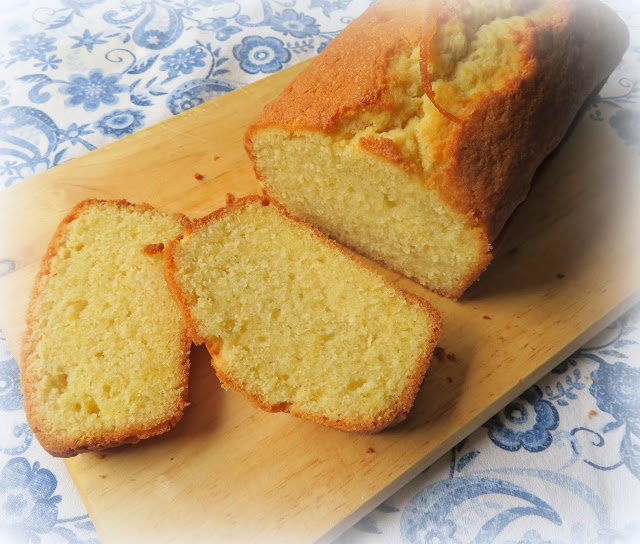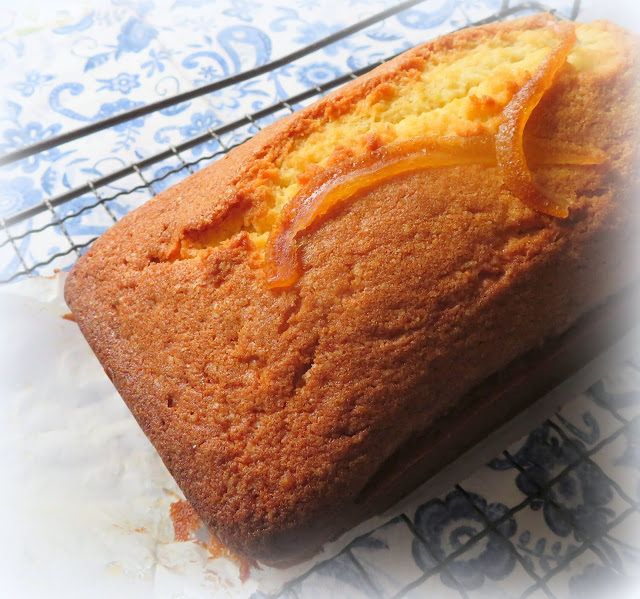One of my favourite of all the British cakes has to be the Madeira Cake. It is a very easy cake to make. It can be quite unremarkable to look at, but when done properly, it is quite simply a lovely cake to eat and to enjoy!
I have often thought it is very reminiscent of North America Pound Cake. It has a dense moist crumb and a beautiful texture.
My mother would often buy a slab of pound cake when she shopped for our groceries. For us it was a real treat! We did not get sweet things or dessert very often.
My mother had been overweight as a child, a chubby young girl. It was really important to her that her children not suffer the same fate. As a result sweet and fattening things were a rarity in our home, which only made them more desirable.
She would cut the pound cake into thin slices and serve it with tinned peaches or ice cream for dessert, and if we were really lucky all three!
Nothing ever tasted better to our way of thinking. Or maybe we were just starved for dessert. I think not however as Pound Cake is a favourite with many people and they can't all be wrong!
You would think with a name like Madeira Cake, this cake would have a somewhat exotic history. Alas, it does not.
Whilst its ingredients are about as simple as you can get . . . butter, sugar, lemon zest, eggs, flour and milk . . . its history is a bit less straightforward . . .
There are a few misconceptions about this cake . . . one being that it hails from the Portuguese Island of Madeira, and another that it contains Madeira wine . . . neither of which is true. This cake is quintessentially, purely British in origin!
I kid you not! Its quite true.
One of its earliest published recipes was by Eliza Acton in her book, Modern cookery for Private families in 1845. Her recipe went as follows:
The name Madeira comes from the early British penchant for enjoying slivers of this delectable cake along with glasses of Madeira wine, which complemented it perfectly, or so I am told. (I don't drink wine so I can't tell you for sure!)
I can tell you, however, that is has a firm light texture which I find quite enjoyable. Its not light in the least, quite like a pound cake.
Its dense crumbly texture makes it the ideal cake for enjoying with a hot cuppa! You can also find it with cherries in it and I have seen it in the shops, split, filled with a thin layer of butter cream icing and then decorated with a glace icing on top.
You can buy it here in narrow slabs, iced or not, with or without cherries, sometimes with nuts, often split and iced with a butter icing in the middle and a glaze icing on top.
I prefer it this way . . . plain and simple. At its very basic as befits a fabulous cake which has enough redeeming qualities as to render it totally enjoyable all on its own, with only a hot cuppa to go along with it.
Traditionally thin slivers of candied lemon peel are laid across the top while it is baking . . .
I am not sure why this is done . . . but it does add a nice bit of decoration to an otherwise very plain cake . . . or maybe it is to help to disguise the inevitable crack which always shows up along the top of the cake.
I am rather fond of the flavour of peel myself. Today I candied my own peel to lay across the top of this cake.
The cake itself is flavoured plainly with some lemon zest, although I have also seen people add vanilla to it . . .
I prefer it with just lemon, but then . . . I am a simple girl with simple tastes. It does not take a lot to please me. Simple things done well will do the trick every time.
With vanilla or without . . . candied lemon on top or not . . . with wine or with tea . . . I think you will agree with me in thinking that this is a most agreeable and delicious cake to enjoy no matter how you choose to enjoy it!
Boy
I tell you this simple cake blows that horrible almond/omelet cake that
I baked the other day right out of the water! I would much rather have
a real cake. There is no real comparison at all! You can't beat the real thing.
Madeira Cake

Yield: Serves 8
A lovely teatime cake. Dense and delicious and lightly flavoured with lemon.
ingredients:
- 175g softened butter (3/4 cup)
- 175g caster sugar (1 cup minus 2 TBS)
- the finely grated zest of one lemon
- 3 large free range eggs, beaten
- 115g plain flour (1 cup, less 2 1/2 TBS)
- 115g self raising flour (1 cup, less 2 1/2 TBS)
- 1 - 2 TBS whole milk
- thin slivers of candied lemon peel to decorate the top
instructions:
How to cook Madeira Cake
- Preheat the oven to 180*C/350*F/ gas mark 4. Butter and line a medium sized loaf tin with baking paper.
- Sift the flours together. Set aside.
- Rub the lemon peel into the sugar until very fragrant. Cream together with the softened butter until light and fluffy. Beat in the eggs a bit at a time. If the mixture starts to curdle at all, add a spoonful of the flour as needed. Fold the remaining flour into the creamed mixture. Stir in milk as needed to give you a batter with a soft dropping consistency.
- Spoon the batter into the prepared pan, levelling the surface. Bake in the pre-heated oven for 20 minutes. Carefully remove from the oven and lay the lemon peel on top, then return to the oven and bake for a further 40 minutes or until golden and a toothpick inserted in the centre comes out clean.
- Let cool in the tin for 10 minutes before lifting out onto a wire rack to cool completely. Cut into slices to serve. You can dust with icing sugar if you wish. Store any leftovers in an airtight container.
This content (written and photography) is the sole property of The English Kitchen. Any reposting or misuse is not permitted. If you are reading this elsewhere, please know that it is stolen content and you may report it to me at: theenglishkitchen@mail.com





















I like little tea cakes such as these..simple but delicious.
ReplyDeleteThis is quite nice. Not too sweet. xoxo
DeleteMadeira cake,simply the best ��
ReplyDeleteI agree! Its my favourite! xoxo
DeleteMarie, what are the dimensions of your 'medium sized' loaf tin? I am in the United States and we have 8"x4" (20cm x 10cm) loaf tins and 9"x5" (23cm x 12.5cm) loaf tins.
ReplyDeleteThank you for your time and for sharing your beautiful recipes.
Hi Monica, I used an 8" by 4" tin for this recipe! I hope it helps. Thanks so much for your sweet comment. It is a labor of love for me! xo
Delete